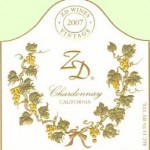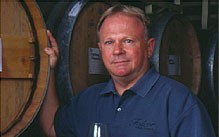I have to admit, I have been very critical in recent years about how certain winemakers, usually from
California, vinify perhaps the greatest of all white wines - chardonnay. In a word, too many chardonnays are “overdone.”
How? Well, some chardonnay growers allow the grapes to get overripe on the vine which produces not only hot, high alcohol wines, but also ones that lack balancing acidity. Then, many of these same wines are put in new wood barrels and allowed to absorb huge amounts of oak flavors, completely overwhelming the fruit and producing a wine that doesn’t even resemble something that once actually grew on a vine.
What you’re left with is a beverage that’s about as subtle as “White Lightnin' ” without the benefit of corn liquor’s kick! And forget about matching the stuff with food unless your tastes run to dishes like anaconda and habanero casserole.Now, I am not the first wine writer to criticize chardonnay made in this bombastic manner, but I may be one of the first to complain about the knee-jerk response to this style by other wine makers. I refer to them as the ascetic school of chardonnay producers.
These guys have ridden the pendulum to the other extreme, making some of the most austere, acidic and painfully bland chardonnay in a pitiful attempt to capitalize on the criticism with the overblown stuff.
Help! Is there anyone out there who can restore sanity and a sense of balance to producing this absolutely wonderful wine???
Just when you’re ready to give up on ever enjoying a chardonnay that actually reaches it’s enormous potential….bam, pow wee.. you taste something that renews your faith in the unpredictability of wine.
So there I was in a restaurant called Frank’s at Pawley’s Island, escaping from the brutal frigidity of
Charleston to bask in the near temperate climes of North Cack-a-lacky when, to my lips, I placed a glass of chardonnay.
Hoakey Smokes! The stuff was subtle, creamy, rich yet balanced, and tasted like the fruit of a grape called… chardonnay! And no, this was not a $200 bottle of white Burgundy or even some trophy wine from Napa. It is the 2007 ZD (California) Chardonnay.
At about $25 a bottle, the wine has a “California” appellation, meaning that the grapes for it could have come from anywhere in the state – not necessarily a prime location like Carneros or Santa Rita Hills, Napa or Sonoma.
I drank the wine with grilled grouper and the combination was a testament to the old axiom about the whole being greater than the sum of the parts. What a superb match.
Lest I be misunderstood, I would not describe the wine as great. It is just very good and very true to the varietal grape – chardonnay – from which it was made. However, in producing a wine that is the purest essence of chardonnay, ZD deserves kudos.
Here are some other wineries that seem to produce balanced chardonnay year in and year out: Chateau Monelena; Talley Vineyards; Acacia; Pine Ridge; Montes Alpha; Merryvale Starmont; and Alamos.
Go get you some!


